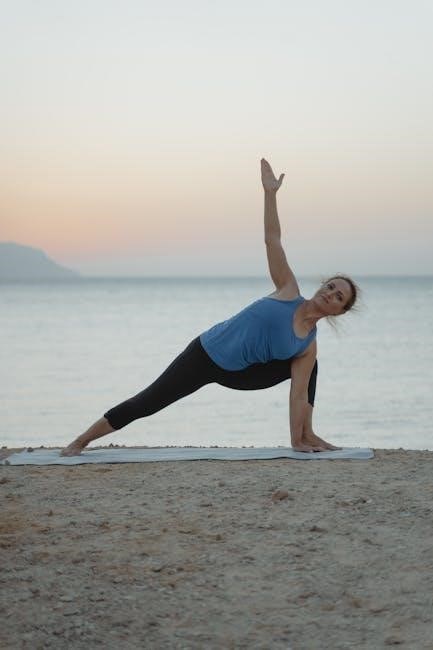The Cawthorne Cooksey exercises are balance retraining exercises,
available as a pdf online, helping patients overcome
disequilibrium and related issues with regular practice and patience.
Overview of the Exercises
The Cawthorne Cooksey exercises are a set of balance retraining exercises,
available as a pdf online, designed to help patients overcome
disequilibrium and related issues. These exercises are typically performed in
a series of stages, starting with simple eye and head movements, and progressing
to more complex activities. The exercises are usually done in a sitting or
standing position, and may involve focusing on a fixed point, moving the head
from side to side, or practicing good balance in everyday situations. The
exercises are designed to be gentle and progressive, allowing patients to
build up their tolerance to abnormal balance signals in the brain. By
practicing these exercises regularly, patients can improve their balance and
reduce their symptoms of dizziness and disequilibrium, and the exercises can be
found in a pdf format for easy access.
Purpose of the Exercises
The purpose of the Cawthorne Cooksey exercises is to help patients overcome
disequilibrium and related issues by building up a tolerance mechanism. The
exercises are designed to be performed regularly, with the goal of reducing
symptoms of dizziness and improving balance. By practicing these exercises,
patients can improve their ability to cope with abnormal balance signals in
the brain, and reduce their reliance on other senses to maintain balance. The
exercises are typically used to treat patients with vestibular disorders,
including those caused by damage to the inner ear or brain. The exercises can
be found in a pdf format, making it easy for patients to
access and follow the exercises. Regular practice of the exercises is
essential to achieving the desired results, and patients are encouraged to
work with a healthcare professional to develop a personalized exercise plan.

Principles of the Cawthorne Cooksey Exercises
Balance parts of the ears send equal impulses to the brain online.
Balance and Equilibrium

The balance parts of the two ears compliment each other, sending equal impulses to the brain, which are essential for the maintenance of equilibrium of the head and body.
The Cawthorne Cooksey exercises are designed to help patients overcome disequilibrium and related issues, by practicing specific movements and activities that challenge the balance system.
These exercises can be found online as a pdf document, providing patients with a convenient and accessible way to practice and improve their balance and equilibrium.
The goal of these exercises is to build up a tolerance mechanism, allowing patients to gradually become more comfortable with movements and activities that previously caused dizziness or discomfort.
By regularly practicing the Cawthorne Cooksey exercises, patients can improve their overall balance and equilibrium, reducing their risk of falls and injuries, and enhancing their quality of life.
Consequences of Damaged Balance Centres
Damaged balance centres can have significant consequences, including loss of equilibrium and balance, leading to dizziness, vertigo, and increased risk of falls and injuries.
The Cawthorne Cooksey exercises, available as a pdf online, are designed to help patients overcome these issues.
When balance centres are damaged, the brain receives uneven impulses, disrupting the body’s ability to maintain balance and equilibrium.
This can lead to a range of symptoms, including nausea, vomiting, and headaches, in addition to dizziness and vertigo.
Damaged balance centres can also affect a person’s quality of life, making everyday activities challenging and increasing the risk of accidents and injuries.
By understanding the consequences of damaged balance centres, patients can take steps to address these issues, including practicing the Cawthorne Cooksey exercises to improve their balance and reduce their symptoms.
Regular practice can help patients regain their balance and equilibrium, reducing their risk of falls and injuries.

Benefits of the Cawthorne Cooksey Exercises
Exercises improve balance, reduce dizziness, available as a pdf online.
Aims of the Exercises
The Cawthorne Cooksey exercises have several key aims, including relaxing the neck and shoulder muscles, which can become tense and contribute to dizziness and discomfort.
The exercises also aim to train the eyes to move independently of the head, which can help to improve balance and reduce symptoms.
Additionally, the exercises aim to practise good balance in everyday situations, such as walking or standing, and to improve general co-ordination and overall sense of balance.
By achieving these aims, the exercises can help patients to overcome their balance problems and improve their overall quality of life, with exercises available as a pdf online for easy access.
Effects of the Exercises
The effects of the Cawthorne Cooksey exercises can be significant, leading to improved balance and reduced dizziness and discomfort.
As patients progress with the exercises, they can expect to see a decrease in their symptoms, with some patients experiencing complete resolution of their balance problems.
The exercises can also have a positive impact on overall quality of life, allowing patients to return to their normal activities and improve their sense of wellbeing.
Regular practice of the exercises, which can be found in a pdf online, is essential to achieving these effects and overcoming balance problems.
With consistent practice, patients can develop a tolerance to the abnormal balance signals in their brain, leading to long-term improvement in their balance and overall health, and allowing them to manage their condition effectively.

Performing the Cawthorne Cooksey Exercises
Exercises are done in bed, sitting, or standing, found in a pdf online, with slow movements.
Exercise Instructions
The Cawthorne Cooksey exercises are typically performed in a series of stages, with each stage building on the previous one. The exercises can be found in a downloadable pdf online and are usually done in a quiet and comfortable environment. The instructions for the exercises are straightforward and easy to follow, with a focus on slow and controlled movements. The exercises start with simple eye movements, such as looking up and down, and then progress to more complex movements, such as turning from side to side. The patient is also instructed to focus on a finger moving from 3 feet to 1 foot away from their face. The exercises are designed to be done regularly, with the goal of improving balance and reducing dizziness. By following the instructions and practicing the exercises regularly, patients can expect to see an improvement in their symptoms over time. Regular practice is key to achieving success with the Cawthorne Cooksey exercises.
Progressing with the Exercises
As patients progress with the Cawthorne Cooksey exercises, they can expect to see an improvement in their balance and a reduction in their symptoms. The exercises can be found in a downloadable pdf online and are usually done in a quiet and comfortable environment. It is essential to progress slowly and carefully, as overexertion can exacerbate symptoms. Patients should aim to practice the exercises regularly, ideally 2-3 times a day, and gradually increase the duration and intensity as they become more comfortable. The goal is to make the exercises a part of daily routine, incorporating them into everyday activities. By progressing slowly and consistently, patients can achieve significant improvements in their balance and overall well-being. Regular practice and patience are key to achieving success with the Cawthorne Cooksey exercises and alleviating symptoms of dizziness and imbalance. Consistency is crucial to making progress and achieving long-term benefits.